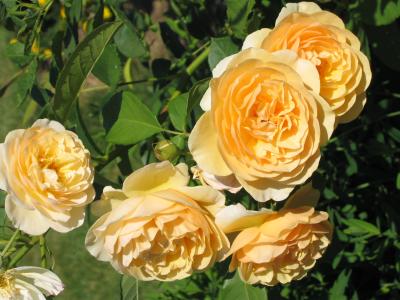FOR IMMEDIATE RELEASE
URBANA, Ill. – Roses, the “Queen of Flowers,” should be in full glory in the month of June. The many colors, scents, and flower sizes are all qualities the rose connoisseur craves. Rose care is not difficult. What roses require, however, is consistent care.
“Roses are heavy feeders, so a regular fertilizer program is essential,” explains Martha Smith, University of Illinois Extension Horticulture Educator. “Disease problems can be controlled with a regular spray program.”
Container-grown roses can be planted any time after mid-May. Choose a sunny area since roses require a minimum of 6 full hours of direct sun. Roses will not tolerate wet soil, so choose a site that has good drainage. Dig a hole deep enough and wide enough to generously accommodate the roots. If the rose is grafted, you need to consider how deep to set the graft union. In warmer climates, position the rose so that the bud union is at or just above ground level. In colder climates, position the bud union 1 to 2" below ground level and mulch over. If your garden soil is heavy clay or very sandy, incorporate compost, peat moss, or leafmold into the backfill. Half-fill the hole, and water to allow any air pockets to settle out. Continue adding back-fill to the hole until full and repeat the watering.
If your roses are stunted, have weak growth, small flowers, pale or discolored leaves, premature petal fall, or poor disease resistance, a regular fertilizer program may solve the problem(s). The Central Illinois Rose Society recommends adding compost or manure every year to the bed, as well as following a fertilizer schedule. A complete fertilizer is recommended May 1, June 1, and July 1. A complete fertilizer contains nitrogen (N), phosphorous (P), and potassium (K). Follow the recommended rates on the label. They also suggest a liquid feed between monthly fertilizing.
In past seasons, some gardeners may have had rose foliage turning yellow with large black spots. This is called black spot and is a very common disease of roses. Infected leaves may drop prematurely. Severe infection may cause some canes to completely defoliate. Fungicide sprays serve as a protectant and must be applied before infection. As the leaves emerge, if day temperatures are above 50 degrees Fahrenheit, begin applying a fungicide every two weeks.
Powdery mildew can also be a problem. It is easily recognized by the white powdery patches that form over the foliage. Powdery mildew can be a problem in shady areas, or where there is very little air movement. Fungicide sprays are again recommended and should be applied when new growth appears and repeated every 7 to 14 days.
One other important practice is proper pruning technique. A rose leaf actually is comprised of several leaflets. Starting at the flower, count the number of leaflets on each leaf. Some will have single leaflets, 3-leaflets, or 5-leaflets. The 5-leaflet leaves have mature buds at their base that will produce a new shoot. Choose an outward-facing, 5-leaflet leaf in the middle of the stem and cut above it. Don't cut back to the lowest. By choosing a mid-level bud, you ensure adequate foliage remains on the plant. An outward facing bud directs new growth away from the center of the plant. Bring cut flowers inside for your enjoyment. Also, prune off faded flowers.
“Any gardener can have success with roses if they follow these guidelines,” Smith says. “Remember, rose care is not difficult, you just need to be consistent.”
For more information on rose care visit Our Rose Garden at https://extension.illinois.edu/roses/
Source/news writer: Martha Smith, 309-734-5161, smithma@illinois.edu
Source: Martha A. Smith, Extension Educator, Horticulture, smithma@illinois.edu
Pull date: May 12, 2020
